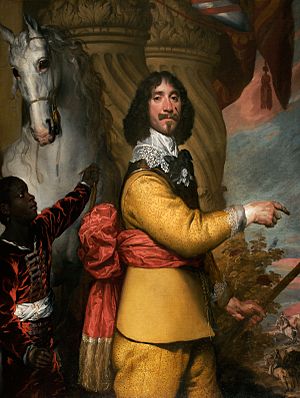Second Battle of Middlewich facts for kids
Quick facts for kids Second Battle of Middlewich |
|||||||
|---|---|---|---|---|---|---|---|
| Part of First English Civil War | |||||||
 Royalist commander Lord Byron |
|||||||
|
|||||||
| Belligerents | |||||||
| Commanders and leaders | |||||||
| Lord Byron Richard Gibson |
Sir William Brereton Alexander Rigby |
||||||
| Strength | |||||||
| 5,000 | 3,000 | ||||||
| Casualties and losses | |||||||
| Unknown | 200 killed | ||||||
The Second Battle of Middlewich happened on December 26, 1643. It took place near Middlewich in Cheshire, England. This battle was part of the First English Civil War. In this fight, a group of soldiers called Royalists, led by Lord Byron, won against a group called Parliamentarians. The Parliamentarian army was commanded by Sir William Brereton.
What Happened Before the Battle
After an earlier victory in March 1643, Parliamentarian forces controlled most of Cheshire. Their main base was at Nantwich. They held about two-thirds of the county. The Royalists controlled the western parts. This included the Dee Valley and the important city of Chester. Chester was vital because it allowed the Royalists to bring in soldiers and supplies. These came from Ireland and North Wales.
During the summer of 1643, the Parliamentarians tried to cut off Chester. They moved into northern Wales in October. To stop this, King Charles I put Lord Byron in charge. Lord Byron was to lead the Royalist forces in Cheshire and Lancashire. In November, he got more soldiers. These troops had been fighting in Ireland.
Lord Byron planned to capture Nantwich first. Then he would clear the Parliamentarians from Cheshire. After that, he would move into Lancashire. On December 12, he left Chester with 4,000 foot soldiers and 1,000 horse soldiers. He began a strong campaign. He pushed back Parliamentarian forces and captured many important places. On December 13, he took Beeston Castle. At Barthomley on December 23, his troops caused some damage.
The Battle Begins
On December 25, Lord Byron and his army were resting at Sandbach. People who supported the Royalists told him that Brereton's army was near Middlewich. At the same time, Brereton's scouts reported a small fight with Royalist soldiers. Because of this, both commanders got their armies ready.
Byron prepared his troops to march seven kilometers to Middlewich. He planned to attack on December 26. Brereton was joined by 1,500 men led by Colonel Alexander Rigby. Brereton placed his soldiers along Booth Lane. His foot soldiers hid in the hedges and ditches. He put his cannons in the middle and horse soldiers on each side.
The Fight at Middlewich
The battle started on December 26. For an hour, there was fierce hand-to-hand fighting. Even though the Royalists had more soldiers, they could not break through the Parliamentarian defenses. Then, Byron ordered his horse soldiers to attack. His foot soldiers, led by Colonel Richard Gibson, supported them.
This forced the Parliamentarians to fall back. They tried to find safety in houses and the church. About 200 Parliamentarian soldiers were killed. Many more were wounded. When Brereton saw that the battle was lost, he and his remaining troops left. They retreated northwest to the safe city of Manchester.
After the Battle
The people living in Middlewich were left to care for the wounded. They also had to bury the dead. The town itself was damaged. It was also searched for food and valuable items. After this, the town suffered from a second outbreak of the plague.
Over the next few weeks, Lord Byron faced little opposition. He captured Parliamentarian bases at Northwich, Crewe Hall, and Doddington Hall. Then, on January 18, 1644, he moved to attack Nantwich. However, Nantwich had a strong group of 1,500 soldiers. They fought back and pushed the Royalists away. Byron's army lost many soldiers.
By this time, Brereton had received more Parliamentarian soldiers. These came from Yorkshire and were led by Sir Thomas Fairfax. On January 25, their combined forces defeated Byron outside Nantwich. Byron then retreated to Chester. He stayed there for most of the next two years.
Looking back, the Royalist wins in December 1643, like the one at Middlewich, were only temporary. Byron's defeat at Nantwich meant Brereton controlled most of Cheshire again. This put the Royalists on the defensive. Chester finally surrendered in February 1646.

